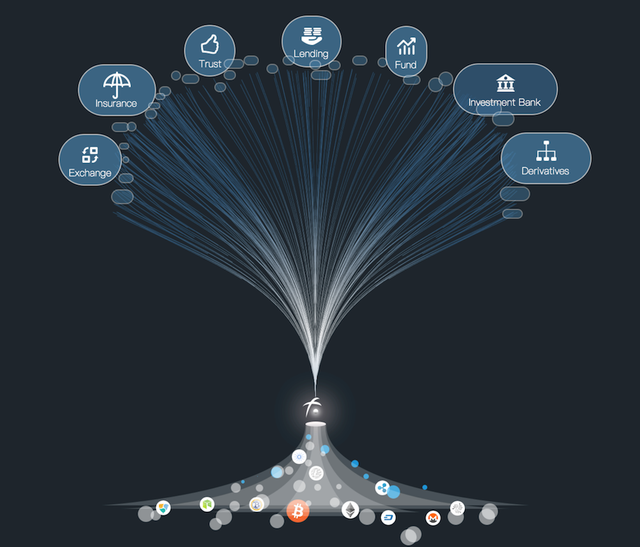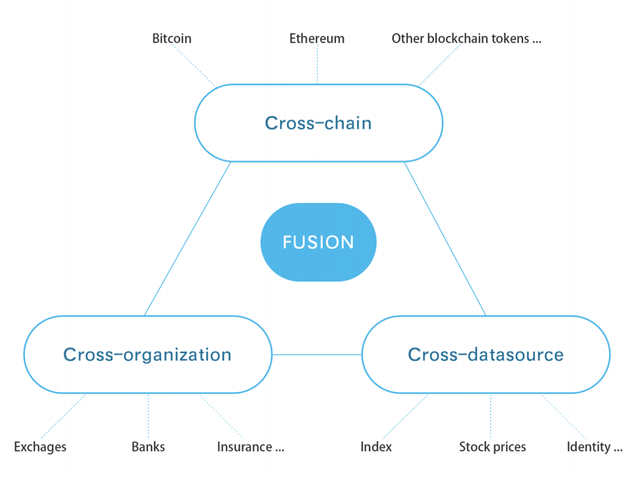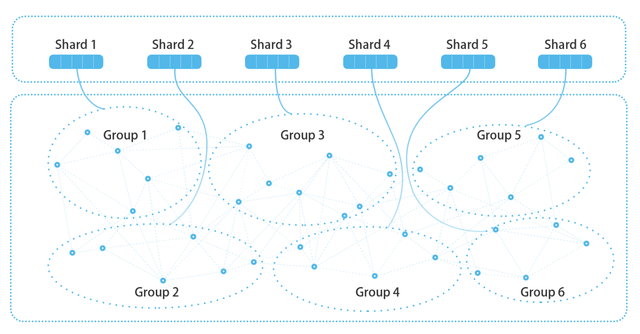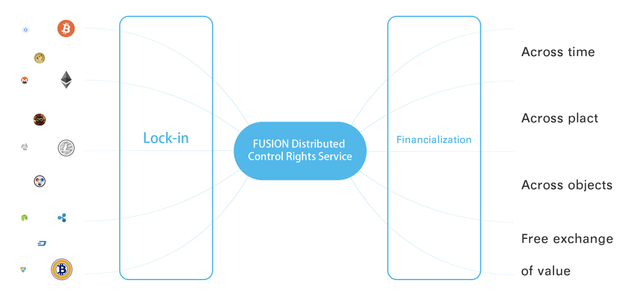The power of nuclear Fusion for the era of Cryptofinance

We are lucky to live in a quite fascinating time: From a geeky trend discussed in a small groups Blockchain is one step from entering our day-to-day life and business. Personally, I don’t believe in a vision that blockchain based decentralization should blow up and replace existing order of things across the variety of industries. What I truly envision is a smooth adoption and integration within existing realm of business and institutions. The World Economic Forum’s Whitepaper (2017) optimistically predicts as much as 10% of world GDP will be stored on the blockchain by 2027 (that’s roughly between 10 to 15 trillion U.S. dollars).
The most exciting part, in my opinion, is the financing sector which is alone multi-trillion industry. Or even broader term introduced by FUSION - Internet of Values for a cryptofinance.

“The essence of the Internet of Values is to map various values to blockchains so they can be controlled by smart contracts. We define the on-chain financial activities on the Internet of Values and their related off-chain financial activities as cryptofinance.”
There are thought three obstacles that set us apart from the bright future: interoperability (connecting different blockchains and organizations), scalability (time=money, we need speed) and usability (feature wise reach framework and off-chain data oracles). Those are stumbling blocks and each team tries to address those in its own way. I bet you could name several projects out there that target interoperability, and of course well known Ethereum‘s Casper (Proof of Stake concept) which is an attempt to solve the scalability issue. But today we are going to look into an ambition promise to solve all those three at a once.
FUSION value proposition
FUSION at its core is Ethereum based network that leverages Ethereum EVM at the beginning, with subsequent plans to integrate JVM that eventually would allow supporting Java and Scala as programming languages (which among top used in financing). Now, what sets FUSION apart is its additional layer on top of core Ethereum based network with some bright ideas, that essentially makes FUSION among top projects of 2018, in my opinion. Let’s dive in and dissect what is so interesting about it.

Distributed Control Rights Management
At its core interoperability means obtaining control over the original asset and emitting mapped asset to a target environment. In reality, at least for blockchain based assets, it would involve controlling a private key of corresponding address (e.g. ETH or BTC) which itself raises a lot of trust issues. To tackle this issue FUSION introduces Key Sharding mechanism (the process of dividing a complete key into several parts), which is based on an idea from original Shamir’s 1979 paper:
None of the group has control over complete private key
In such setup, transaction is signed by combining signature pieces from shard groups and the private key never appears as a whole in the network. The process of transfer as simple as locking your original fund to controlled address and receiving a mapped token (I assume a form of ERC-20 within FUSION blockchain) and vice-versa. Mapped assets are controlled by a smart-contracts, similar to how the Ethereum operates.
Cryptofinancial Smart Contracts
Of course, to have rich logic to serve a complex cryptofinancial applications we will need more than just transactional triggered smart-contracts. This includes real-time data (like stock prices, or weather), as well as off-chain data which all could act as a trigger for smart-contract execution.
According to FUSION’s plan, all these rich functionalities will be available for developers via the framework, along with templates for common financial applications.
In addition to that, FUSION also wants to introduce a separation of usufructs (in simple terms, suppose you want to give to someone a share in revenue generated from lending an asset, but not a share in owning an asset itself). What does it mean for us? Here’re few examples from a whitepaper:
Taking the application of borrowing money to participate in an ICO as an example, the FUSION smart contract can be programmed to borrow tokens, return new currency and pay interest.
Taking a fund application as an example, the smart contract on the FUSION platform can automatically manage a fund: accepting the usufruct of various tokens into a smart contract, investing various digital assets, generating management fees, paying the dividend, etc.
I’m quite intrigued by this part, hence this alone could create a variety of use-cases for the financial sector and crypto-community.

Hierarchical Hybrid Consensus Mechanism
The most commonly used consensus mechanism nowadays are: PoW (Proof of Work) and PoS (Proof of Stake) each one with its own pros/cons. But none of them allows an ambitious goal of parallel computing which is what FUSION tries to achieve with HHCM:
.png)
The parallel computing is done by a dynamic grouping on Layer 1. Each virtual group is responsible to make calculation for an independent part of operations/transactions (meaning, the parties involved in transaction calculated by Group1 do not overlap with such in Group2). The randomness and grouping are controlled by the network, which allows balancing the throughput as needed.
Only one node (“representative”) from each group is elected for a Layer 2-PoW, the chances to be elected will depend on stacking attributes (volume and duration staked), an additional randomness is guaranteed by algorithm similar to the Algorand consensus algorithm. At Layer 2 the number of nodes working according to PoW is equal to the number of groups agreed to by the system. The winning node from Layer 2 will end up creating a new block.

Roadmap and plans
The plans as ambitious as the whole tech of the project. We should see a test-net by Q1/early Q2. To highlight some of the actions within 2018:
Q2: Main net launch with wallet and basic smart-contracts; 10 billion US dollars of distributed control services;
Q3: 100 billion US dollars of distributed control service; > 1 billion US dollars of cryptofinancial applications;
Last but not least — the team
There was a bit of uncertainty in the community regarding the connection between Dejun Qian (CEO of FUSION) and VeChain/QTUM via BitSE, but I believe it all was cleared out completely. For anyone who still has some doubts, I’ll just leave a link where takes a keynote on VeChain Official Launch Day. Overall the team looks solid (you could check out on the official website) and having such a visionary as Dejun Qian is a huge advantage. But in addition to that FUSION Foundation was able to engage quite a few noticeable people from financial sector:
David Perez: Co-founder and managing partner of YAD; Managing director of Goldman Sachs
Daniel P. Petrozzo: Partner and Global Head of Technology for investment management at Goldman Sachs
Sean Walsh: CEO Hyperblock Technologies; VP Bertram Capital; VP of online marketing, Bank of America
Michael Hosana: Managing Director of Barclays Investment Bank; Equity Derivatives Trading of Lehman Brothers
And over 37 supporters in a growing list!
Summary
From what I’ve seen so far this could be the most under-the-radar project of 2018. The key highlights:
Interoperability: Asset mapping and distributed control rights management (key sharding);
Scalability: Hierarchical Hybrid Consensus Mechanism (two layer PoS+PoW consensus with dynamic throughput control);
Usability: Rich smart-contract framework with various trigger sources and separation of ownership and usufruct.
The pressure of ambition plans will definitely create a tension. But as soon as the first huge milestone is achieved by the team, it will explode exponentially in my opinion. It will depend on execution solely, though.

ICO Drops Page: https://icodrops.com/fusion/
Official Website: https://fusion.org/